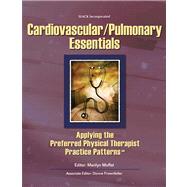
Note: Supplemental materials are not guaranteed with Rental or Used book purchases.
Purchase Benefits
What is included with this book?
| Dedication | |
| Acknowledgments | |
| About the Editors | |
| Contributing Authors | |
| Preface | |
| Foreword to the Essentials in Physical Therapy Series | |
| Foreword to Cardiovascular/Pulmonary Essentials | |
| Introduction | |
| Primary Prevention/Risk Reduction for Cardiovascular/Pulmonary Disorders (Pattern A) | |
| Impaired Aerobic Capacity/Endurance Associated With Deconditioning (Pattern B) | |
| Impaired Ventilation, Respiration/Gas Exchange and Aerobic Capacity/Endurance Associated With Airway Clearance Dysfunction (Pattern C) | |
| Impaired Aerobic Capacity/Endurance Associated With Cardiovascular Pump Dysfunctionor Failure (Pattern D) | |
| Impaired Ventilation and Respiration/Gas Exchange Associated With Ventilatory Pump Dysfunction or Failure (Pattern E) | |
| Impaired Ventilation and Respiration/Gas Exchange Associated With Respiratory Failure (Pattern F) | |
| Impaired Ventilation, Respiration/Gas Exchange, and Aerobic Capacity/Endurance Associated With Respiratory Failure in the Neonate (Pattern G) | |
| Impaired Circulation and Anthropometric Dimensions Associated With Lymphatic System Disorders (Pattern H) | |
| Abbreviations Brand Name Drugs and Products | |
| Index | |
| Table of Contents provided by Publisher. All Rights Reserved. |
The New copy of this book will include any supplemental materials advertised. Please check the title of the book to determine if it should include any access cards, study guides, lab manuals, CDs, etc.
The Used, Rental and eBook copies of this book are not guaranteed to include any supplemental materials. Typically, only the book itself is included. This is true even if the title states it includes any access cards, study guides, lab manuals, CDs, etc.